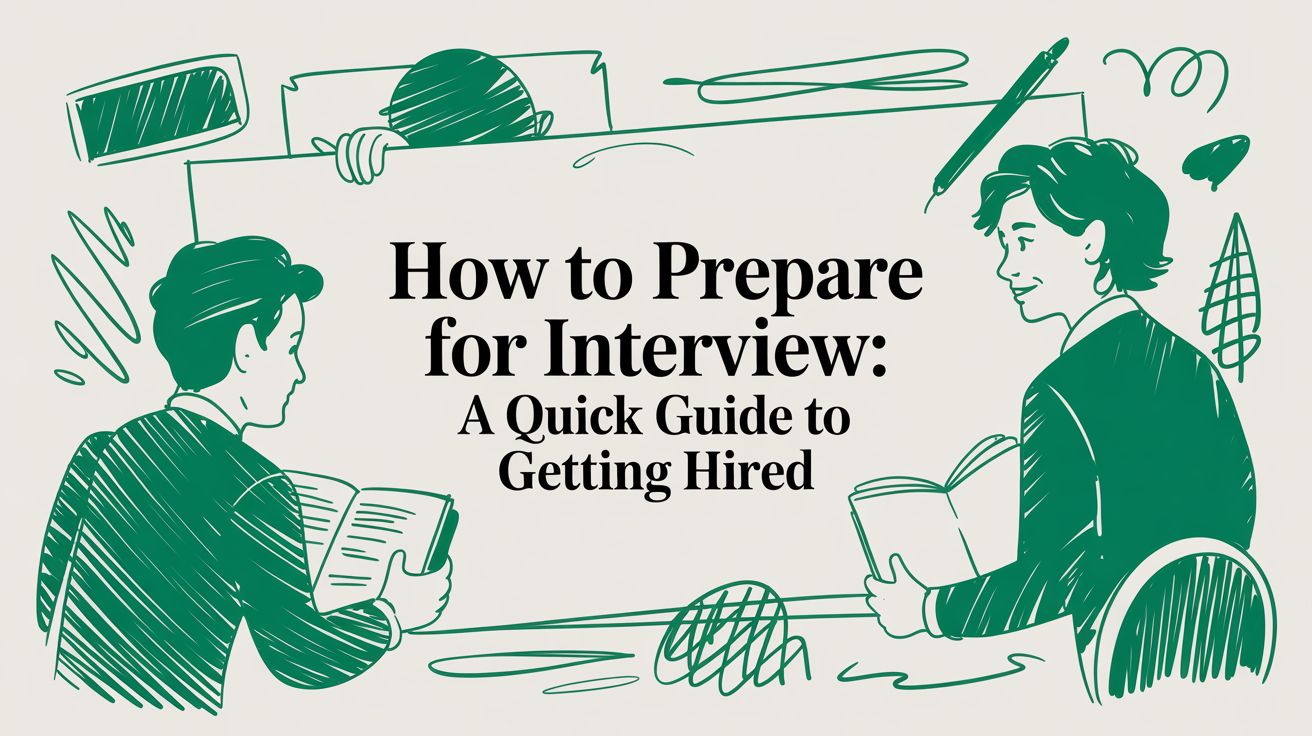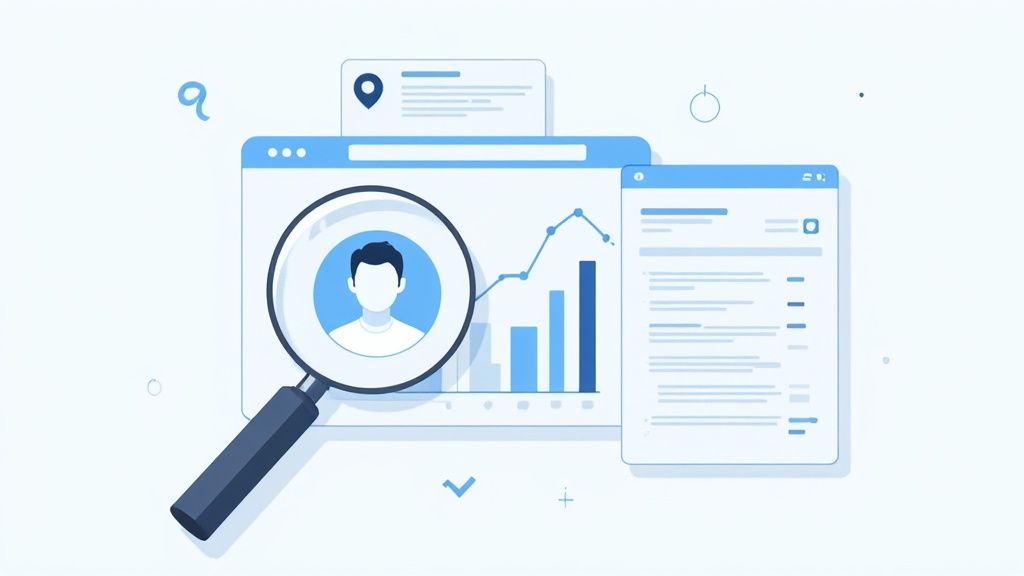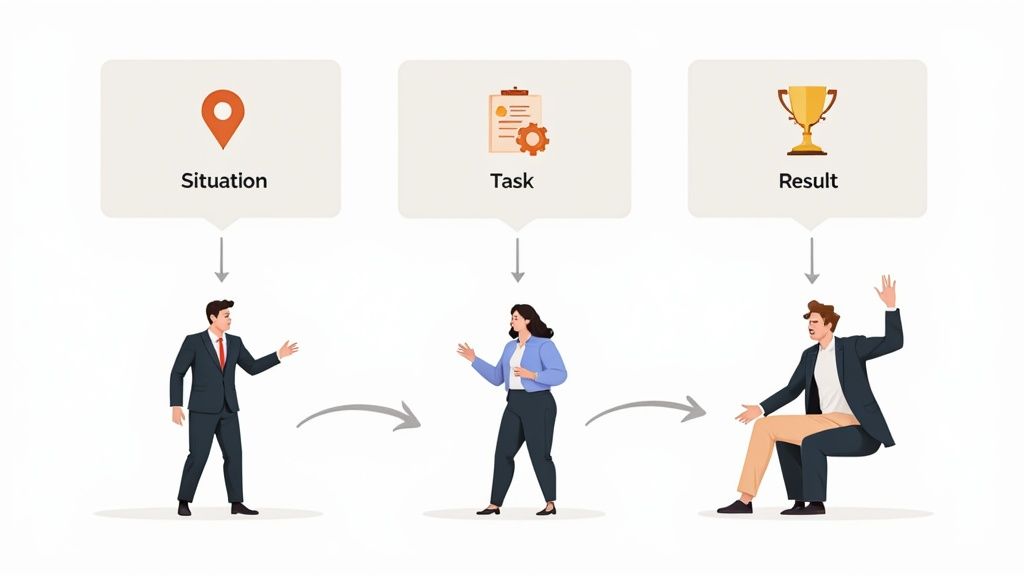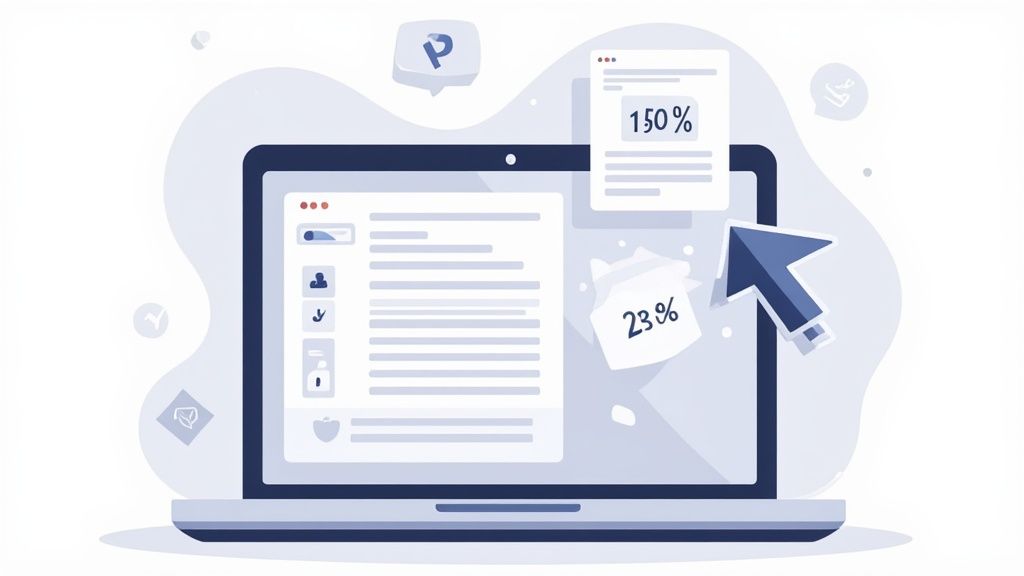how to prepare for interview: A quick guide to getting hired

Landing a great marketing role takes more than just a sharp resume. Your interview preparation needs to be just as strategic as any campaign you'd run. Think of it in four key parts: digging deep into the company, nailing your story with the STAR method, showcasing your best work, and getting the logistics right.
When you break it down like this, you move past just winging it and start building a powerful, confident case for why you're the one they need.
Navigating the Modern Marketing Interview

Let's be real: interviewing for marketing and communications jobs has completely changed. It’s not just a friendly chat anymore. You're often up against applicant tracking systems, multiple rounds of video calls, and a ton of competition.
Consider this: an average of 118 people apply for any given job, but only about 20% of them actually land an interview. That means from the moment you apply, you’re competing with a crowd of qualified professionals. This isn't to scare you, but to set the stage—preparation is everything.
This guide is your roadmap to cutting through that noise. We're skipping the fluffy, generic advice and getting straight to what actually works.
The goal isn't just to answer questions. It's to demonstrate that you are the solution to the company's specific problems, and preparation is how you build that case.
A Framework for Success
Your prep work shouldn't feel like a frantic scramble. It’s a campaign, and the product is you. Each stage builds on the last, creating a narrative that’s impossible for hiring managers to ignore.
Here's a quick look at the game plan we'll walk through:
Your Interview Preparation Checklist at a Glance
This table breaks down the core stages of your prep. Think of it as your high-level strategy map for the entire process.
| Preparation Stage | Key Objective | Why It Matters |
|---|---|---|
| Deep Company & Role Research | Understand their pain points, goals, and culture. | Shows genuine interest and helps you tailor every answer. |
| Crafting Your Career Stories | Turn experiences into memorable, results-driven narratives. | Proves your value with concrete evidence, not just claims. |
| Curating Your Portfolio | Select case studies that mirror the job's challenges. | Visually demonstrates your skills and strategic thinking. |
| Mastering Interview Logistics | Ensure flawless execution, whether virtual or in-person. | Prevents technical glitches from overshadowing your talent. |
Each of these pieces is crucial. Nailing your prep not only helps you get the offer but also gives you the confidence to negotiate from a position of strength. A stellar interview performance is your biggest leverage point when it's time to discuss your what is total compensation package.
Laying the Groundwork with Deep-Dive Research

Here's a secret most candidates don't get: glancing at the company's "About Us" page is not preparation. It's the bare minimum. To really nail the interview, you need to go so much deeper. Think of yourself as an investigative journalist for an afternoon.
This initial deep-dive research is your foundation. It’s not just about reciting their mission statement back to them. It’s about understanding their world, their pain points, and their wins so you can walk in and talk like you’re already part of the team.
Unpack the Job Description
That job description? It's your cheat sheet. It’s a detailed outline of the exact problems they need solved and the skills they think will solve them. Don’t just skim it—dissect it.
I always recommend copying the key responsibilities and qualifications into a fresh document. Then, right next to each line item, map a specific project or achievement from your own career. This simple act forces you to connect your experience directly to their needs.
For example, if the description mentions "manage a content calendar," don't just nod and say you've done it. Have a story ready about how you built a calendar from scratch, aligned it with sales goals, and tracked its performance to show a tangible business impact. Now you’re not just a candidate; you’re a solution.
Get Inside Their Marketing and Business Strategy
To truly impress, you need to understand where the company sits in its market and what its goals are. This is where you elevate yourself from applicant to strategic partner in the hiring manager's mind.
Start by auditing their recent marketing efforts. You need to see what they’re actually doing.
- Social Media: Which channels are their focus? What's the tone of voice? Dig into what gets the most engagement and try to figure out why.
- Content: Go read their blog, download an ebook, or sit through a webinar. What are the common themes? Do you see a gap in their strategy you could fill?
- Paid Ads: Jump into tools like the Meta Ad Library to see their current campaigns. Who are they targeting? What’s the core message?
Then, zoom out to the bigger business picture. If it's a public company, the quarterly earnings reports are pure gold. They spell out the company's real goals, challenges, and growth areas far more honestly than a press release ever will.
I always scan investor call transcripts for phrases like "marketing initiatives" or "customer acquisition." Knowing these high-level pressures allows you to frame your skills as a direct contribution to their bottom line—a game-changer in any interview.
Know Your Audience: Research the Interviewers
Finally, take some time to learn about the people you'll be speaking with. This isn't about being a creep; it's about finding common ground and building genuine rapport. A quick visit to their LinkedIn profile is all it takes.
Look for professional connection points that can spark a real conversation:
- Did you attend the same university or work for a similar company in the past?
- Have they recently published an article or spoken at an industry event?
- Do you have any mutual connections who could give you some insight?
Casually mentioning a recent blog post they wrote or a project they spearheaded shows you’ve done your homework and that you respect their work. It instantly changes the dynamic from a rigid Q&A to a conversation between two professionals. In a sea of qualified candidates, being memorable and likable is often the deciding factor.
Crafting Compelling Stories with the STAR Method

When an interviewer leans in and says, "Tell me about a time when...," they're asking for more than just a job description. They want to see how you think, act, and get results. These behavioral questions are the heart of a modern marketing interview, and simply saying you're a great collaborator won't cut it. You have to prove it with a story.
This is exactly where the STAR method becomes your secret weapon. It’s a simple, powerful framework for turning your experiences into compelling narratives that stick. The acronym—Situation, Task, Action, Result—is your roadmap to a clear, concise, and impactful answer. It stops you from rambling and ensures you hit all the key points, especially the result, which is where the real magic happens.
Mastering this is a fundamental part of interview prep. It’s how you transform past accomplishments into solid proof of the value you'll bring to their team.
Deconstructing the STAR Method for Marketers
Each part of the STAR framework has a specific job to do in building your story. Let's break down how to apply it to the real-world scenarios you face in marketing and communications.
- Situation: Start by setting the scene. What was the business challenge or project context? Keep it brief—just enough background for your story to make sense.
- Task: What was your specific mission? This defines your role and responsibility. Were you tasked with boosting lead generation, fixing a brand reputation issue, or launching a new product?
- Action: This is the hero's journey part of your story. Detail the specific steps you took to tackle the task. Use strong verbs and focus on your personal contributions, even within a team. What was your strategy? What did you do?
- Result: This is the mic drop moment and, critically, the part people most often forget. What happened because of your actions? Quantify everything you can. Numbers tell a much louder story than vague claims.
The best STAR answers are essentially mini-case studies. They don't just list your duties; they showcase your strategic thinking, your initiative, and the tangible, bottom-line value you created.
Let's walk through a concrete example. An interviewer might ask, "Tell me about a time you turned around a struggling campaign."
STAR Method Breakdown for a Marketing Campaign
Here’s a practical table showing how you can map a real marketing experience to the STAR framework.
| Component | Description | Marketing Example |
|---|---|---|
| Situation | Set the stage with brief, relevant context. | "In my last role as a Content Marketing Manager, our organic blog traffic had been flat for two consecutive quarters, and our lead conversion rate from content was below our 5% target." |
| Task | Define your specific goal or objective. | "My task was to develop and execute a new content strategy to increase organic traffic by 20% and boost our content-to-lead conversion rate within one quarter." |
| Action | Describe the specific actions you took. | "I started by conducting a comprehensive content audit and keyword gap analysis. I then built a new content calendar focused on bottom-of-the-funnel topics, introduced new formats like interactive quizzes, and optimized all existing high-potential posts with updated CTAs and internal links." |
| Result | Quantify the outcome with specific metrics. | "By the end of the quarter, organic traffic increased by 28%, exceeding our goal. More importantly, the lead conversion rate from our blog content jumped from 3.5% to 6.2%, generating an additional 150 qualified leads for the sales team." |
See the difference? That detailed, data-driven answer is infinitely more powerful than just saying, "I improved our blog." It proves your strategic thinking and your direct impact on the business.
Brainstorming and Preparing Your Stories
The time to come up with these stories is before the interview, not during it. The best performers walk in with a mental library of go-to examples. Open a doc and start mapping your career highlights to common behavioral prompts.
Think through these classic interview scenarios:
- A big win: A project that blew its goals out of the water.
- A lesson learned: A time something went wrong and what you took from it.
- Teamwork in action: A complex project that required cross-functional collaboration.
- Managing up (or out): A time you navigated a difficult client or internal stakeholder.
- Taking initiative: A moment you saw a problem and fixed it without being told.
For each one, outline the Situation, Task, Action, and Result. Then, practice saying them out loud until they roll off your tongue naturally. Having three to five of these rock-solid, data-backed stories in your back pocket means you can confidently handle almost any behavioral question they throw at you.
Showcasing Your Work with a Polished Portfolio

If your resume makes the claims, your portfolio is what closes the deal. For any serious marketing or communications pro, a well-curated portfolio isn't just a "nice-to-have"—it's an absolute essential for interview prep. It’s what turns your career stories from abstract claims into concrete, evidence-backed case studies.
Think of it this way: your portfolio is where you stop telling them what you can do and start showing them. It’s your opportunity to visually connect your best work to their biggest challenges, proving your value before they even ask.
Curating Your Best Work
A truly great portfolio isn’t a digital dumping ground for every project you’ve ever touched. It’s a strategic, curated collection of your most impressive and, more importantly, relevant work. Quality always trumps quantity here.
I always advise people to aim for three to five high-impact case studies that speak directly to the job description.
Think critically about what the role demands and choose your examples to match.
- Going for an SEO role? You’d better have a case study showing how you grew organic traffic, complete with clear charts and data.
- Interviewing for a social media manager position? Pull up the campaign that drove massive engagement, showing off the analytics and screenshots.
- Vying for that PR job? Feature the campaign where you landed top-tier media placements, with links to the articles and their reach metrics.
Every single piece you include should have a purpose. It should preemptively answer a question and reinforce the idea that you are the solution they’ve been looking for.
Your portfolio should feel like a direct response to the job description. Each case study is a piece of evidence proving you have successfully solved the exact types of challenges they are currently facing.
Structuring a Powerful Case Study
The way you frame your work is just as crucial as the work itself. Each project needs to be presented as a mini case study that’s incredibly easy to digest. A hiring manager should be able to look at it and understand the entire story in less than a minute.
I've found a simple, consistent format works best. It makes your portfolio a breeze to navigate and subtly shows off your logical, results-driven thinking.
Here’s a structure that has never failed me:
- The Problem: Start with a brief, clear outline of the business challenge. What was the goal?
- Your Approach: Explain your strategy. What was the core insight that drove your plan?
- The Execution: Detail the specific actions you took. What content did you create? What channels did you use? Who did you collaborate with?
- The Results: This is the knockout punch. Quantify your impact with cold, hard numbers. Don’t just say "increased traffic"—say "increased organic traffic by 150% in six months."
Presenting Your Portfolio Seamlessly
All that brilliant work is useless if you fumble the presentation. You need a game plan for every possible interview format, whether it’s virtual or in person. The goal is to make it completely effortless for them to see what you've done.
Be ready for any scenario:
- Digital Link: Have a polished online portfolio—whether it’s a personal site, a Behance profile, or a slick PDF on Google Drive—ready to go. I always recommend putting this link right in your email signature and on your resume.
- Screen-Share: For any video interview, have your portfolio open and ready to share. Do a quick test run with a friend beforehand to iron out any technical kinks. Trust me, you don’t want to be troubleshooting on the fly.
- Physical Leave-Behind: This is a power move for in-person interviews. Bringing a beautifully printed, high-level summary of your portfolio can leave a lasting impression. It’s a tangible reminder of your professionalism that stays on their desk long after you've left.
Getting the Interview Logistics Right
All the incredible research and perfectly crafted stories in the world won’t matter if a bad connection or a late arrival tanks the interview. Whether you're meeting on screen or in person, nailing the logistics is a non-negotiable part of your prep. Getting these details right shows you're a professional and makes sure your talent is what they remember, not a technical glitch.
Think of it this way: successfully managing the interview setup proves you're organized, respectful of their time, and can execute without a hitch. These are all critical skills in any marketing or communications role. Don't let a simple, preventable mistake get in the way of all your hard work.
Preparing for a Virtual Interview
With remote work being the norm, how you show up on a video call is a huge part of the first impression. As of 2025, around 90% of companies are using video interviews, especially in the early stages. But here's the kicker: 62% of candidates say they've hit technical snags that hurt their performance. And since 76% of people say a smooth interview experience influences their decision to take a job, you can't afford to mess this up. You can find more of these insights in the job interview statistics at PassiveSecrets.com.
To make sure you come across perfectly, run through this quick pre-flight checklist the day before your call:
- Test Your Tech: Don't be that person fumbling with downloads five minutes before go-time. Install and test the platform (Zoom, Google Meet, Teams) well in advance. Check your camera and microphone to make sure you’re coming through crystal clear.
- Set the Scene: Find a spot with a clean, professional background. Clutter is distracting. Good lighting is everything—face a window or use a ring light so your face is clearly visible and not cast in shadows.
- Check Your Connection: A choppy connection can kill the conversation's flow. If your Wi-Fi is unreliable, plug directly into your router with an ethernet cable. It’s a game-changer.
- Have a Backup Plan: Tech will fail you at some point. If your video freezes, don't panic. Just calmly apologize, explain the issue, and suggest a fix, like turning off your video to save bandwidth or quickly rejoining the call.
Here's a pro tip I swear by: put a small sticky note right next to your webcam. It’s a simple reminder to look at the camera, which feels like making direct eye contact with the interviewer on the other end.
Nailing the In-Person Interview
While video calls are standard for initial screenings, the final rounds are often still held face-to-face. The logistics are different, but just as crucial. Your entire goal here is to walk in feeling calm and collected, not frazzled and rushed.
Start by doing a dry run of your commute. A day or two beforehand, map out your route, figure out the parking situation, and know exactly where you need to go once you’re in the building. I always aim to be in the area 15-20 minutes early, but I don't walk into the office until 5-10 minutes before the scheduled time.
For marketing roles, the dress code is usually business casual, but it pays to do a little digging on the company's culture. When in doubt, it’s always better to be a little overdressed than too casual.
Finally, show up prepared. Bring a few crisp copies of your resume, a notepad and pen for taking notes, and your portfolio. Having these materials ready shows you’re serious and organized. This is also the time to bring up your own smart questions about the role, the team, and even compensation. If you're nervous about the money talk, our guide on how to answer salary expectations questions has you covered.
Using AI and Practice to Get Ready for Game Day
Confidence isn't something you can just switch on; you have to earn it through practice. The final push in your interview prep is all about sharpening your delivery. The best way to do this is by blending modern tech with some old-school, real-world practice. This one-two punch is your ticket to walking into that room feeling completely prepared and articulate.
We’re in a pretty amazing time where technology can give us a serious edge. AI platforms are fantastic for simulating the real thing, generating specific questions for a "Marketing Communications Manager" role that go way beyond the generic lists you find with a quick search. It’s a huge advantage for getting your head in the game.
This isn't just a niche trick anymore. By 2025, it's expected that over 20% of companies will be using AI in their hiring process, and 31% of job seekers are already using it to practice questions and polish their answers. But tech isn't the whole story. A whopping 92% of candidates still count on traditional mock interviews to get their confidence up, which makes sense when you consider that 93% of us get interview anxiety. You can dig into the full research on AI hiring trends to see how it's changing the game for job seekers.
Use AI to Drill Your Content
Think of AI as your personal interview coach, on call 24/7. It's the perfect tool for rehearsing the content of your answers without the pressure of a real person watching you. This is how you build the muscle memory for your key accomplishments and STAR stories.
Here’s how to put it to work for you:
- Get Custom Questions: Feed the job description into an AI tool and ask it to spit out a list of likely behavioral, technical, and situational questions. Be specific with your prompt.
- Polish Your Stories: Paste in your drafted STAR answers and ask for feedback. Prompt it to make them punchier, check for clarity, or swap in more powerful action verbs.
- Run a Vocal Drill: Use a voice-to-text app on your phone and practice answering questions out loud. Hearing your words read back to you is a surprisingly effective way to catch awkward phrasing you wouldn't notice otherwise.
An AI can perfect what you say, but only practicing with people can perfect how you say it. Use technology to build a strong foundation, then move on to live drills.
The Unbeatable Value of a Practice Audience
Once your content is solid, it's time for the most important step: practicing with another human being. Nothing can truly replicate the back-and-forth of a real conversation. This is where you get the kind of honest feedback on things an AI just can't measure.
A mock interview with a mentor, a trusted colleague, or a career coach offers priceless insights. They'll catch the little things you're totally blind to, like fidgeting, overusing filler words ("um," "like," "you know"), or looking away when you're making a key point.
Want to take it a step further? Record yourself during a practice run. It can feel a little cringey to watch yourself back, I know, but it is hands-down one of the best ways to spot and fix nervous habits before the actual interview. Combining smart tech with real human interaction is how you get to that peak performance level where you can just be yourself and shine.
Tying Up Loose Ends: Final Interview Questions
It’s completely normal to have those last-minute, nagging questions pop into your head right before an interview. You've done the deep-dive research, you've practiced your stories, and you've got your tech sorted out, but a few "what ifs" can still cause a little anxiety.
Let's tackle those common head-scratchers now. Getting these sorted will give you that final dose of confidence you need to walk in and focus on what truly matters—connecting with the interviewer and showing them what you can do.
How Many Questions Should I Really Have Ready for Them?
I always tell people to have three to five smart questions in their back pocket. You probably won't get to ask all of them, but being prepared shows you're genuinely interested and have thought critically about the role. This is your chance to interview them, too.
Don't just ask about the day-to-day. That's a missed opportunity. Instead of "What's a typical day like?", try something that shows you're already thinking like a problem-solver: "Looking at the next six months, what's the biggest challenge this team is facing that I could help tackle right away?" Now you sound like a strategic partner, not just a candidate.
Can I Ask for More Time to Prepare?
Yes, you absolutely can. If a recruiter catches you off guard and you feel rushed, it's almost always okay to ask for a little more time. This is especially true with larger companies where many roles are "evergreen"—meaning they're constantly hiring for that position. It's far better to push the interview back a week than to bomb it and get locked out from applying again for six months or even a year.
Don't be afraid to be straightforward. Something as simple as, "I'm really excited about this opportunity and want to be sure I'm fully prepared. Would it be possible to schedule our conversation for next week?" sounds professional and shows you’re serious.
What if I Completely Blank on My Answer?
It happens to the best of us. You get a tough question, and your mind just goes... white noise. The most important thing is not to panic.
Take a breath, smile, and say, "That's a great question. Let me think for a moment to find the best example for you." This simple phrase is your secret weapon. It buys you precious seconds to collect your thoughts and shows confidence. It’s much better to pause and give a great answer than to rush into a disorganized one.
Remember, you're not there to recite a script. You've prepared a collection of stories, and if one slips your mind, you can always pivot to another that highlights a similar skill. For more tips on navigating all kinds of questions, check out our guide on common interview questions and answers.
At SalaryGuide, we know that solid preparation is what turns a good candidate into a hired one. We give marketers the tools to succeed, from salary data to proven negotiation advice. Explore SalaryGuide to benchmark your worth and plan your next move.